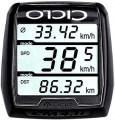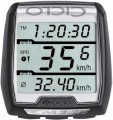Type
The type determines, first of all, the method of communication with the remote wheel speed sensor. Recall that most bike computers are equipped with such a sensor, it is mounted on a fork, and a special magnet is attached to the wheel; when the wheel rotates, the device detects the passage of the magnet past the sensor and determines the revolutions by their frequency. The connection options are:
—
Wired. The advantages of a wired connection are low cost, reliable connection, and the fact that the speed sensor does not require its own battery. And the battery of the computer itself with such a connection “lives” longer than with a wireless one. On the other hand, such devices are somewhat less convenient to install than wireless ones, and in case of an unsuccessful fall or collision, there is a risk of breaking the wire.
—
Wireless. Such a connection allows you to do without unnecessary wires, which greatly simplifies the installation of the bike computer. At the same time, it costs more than a wired one, and two batteries are used in such a system — in the computer itself and in the speed sensor, and you will have to monitor both. Also, if there are many other wireless cycling computers nearby, the connection may fail.
Indications
Readings that can be displayed on the cycle computer display.
—
Current speed. Displays the speed of movement at a given moment.
—
Average speed. Display of the average speed of movement for a certain period, usually from the beginning of the trip to the current moment. The computer calculates this speed using the formula "total distance divided by total time." Note that in such calculations, only the time in motion can be taken into account, without intermediate stops (except for the shortest ones).
—
Maximum speed. Displays the maximum speed reached for a certain period — for a trip, for a day, for all the time since the last reset, etc. The specific features of this function in different models may vary, they need to be specified separately.
—
Ratio current/average speed. The ratio of the speed of the trip at the moment to the average speed for the entire trip. This function allows you to evaluate the current pace of movement and compare it with the pace in the already passed section.
—
Current distance travelled. Displays the distance traveled since the start of the trip.
—
Daily distance travelled. Displays the distance traveled for the current day. The change of day of the model with this function i
...s monitored by its own clock (see "Functions").
— Total distance travelled. Displays the total distance traveled since the last reset of the cycling computer. In some models, it may be possible to reset this counter without a general reset.
— Current travel time. Displays the time elapsed since the start of the current trip. Usually, the countdown starts from the moment the movement starts; during short stops, it can continue or be paused, these points should be clarified separately.
— Total travel time. Displaying the total time spent in motion for a certain period — usually since the last reset of the bike computer settings (or resetting this counter separately, some devices have such an option). Usually, only the time in motion is taken into account, excluding intermediate stops, with the exception of the shortest ones, up to half a minute to a minute.Cadence
Cadence display functions provided in this cycle computer. Note that these functions require the installation of a separate sensor, which is not always included in the package.
Cadence is called the frequency of pedaling (pedaling). This information can be useful, in particular, for choosing the optimal gear and for evaluating the overall effectiveness of the training. The cadence should not be too low (this increases the load and wears out the knee joints) nor too high (this leads to rapid fatigue). Its optimal values may be different, depending on specific conditions; information about this can be found in special sources.
In addition to displaying the current cadence, cycling computers may have a function to display the average cadence (usually for a trip) and the maximum cadence (for a particular period, depending on the model). This data can be used for a variety of purposes, mainly for professional athletes and keen enthusiasts.

